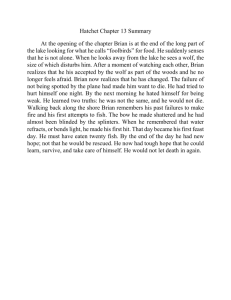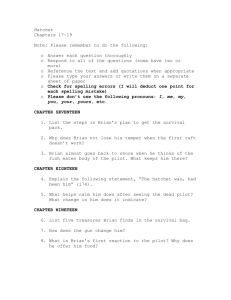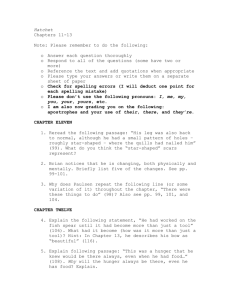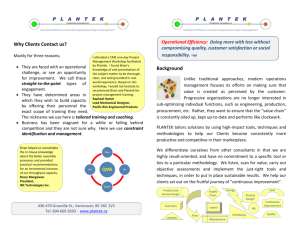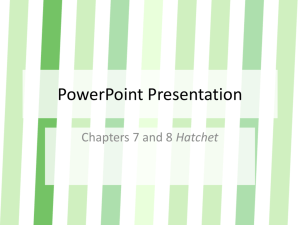Name_____________________________________________
advertisement
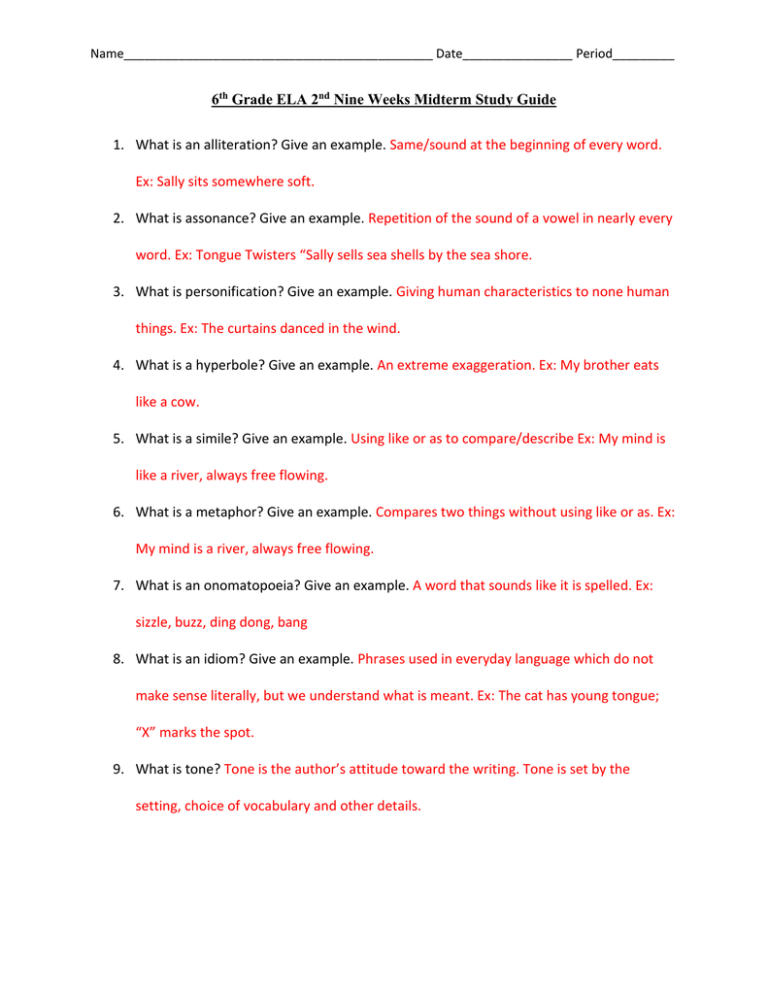
Name_____________________________________________ Date________________ Period_________ 6th Grade ELA 2nd Nine Weeks Midterm Study Guide 1. What is an alliteration? Give an example. Same/sound at the beginning of every word. Ex: Sally sits somewhere soft. 2. What is assonance? Give an example. Repetition of the sound of a vowel in nearly every word. Ex: Tongue Twisters “Sally sells sea shells by the sea shore. 3. What is personification? Give an example. Giving human characteristics to none human things. Ex: The curtains danced in the wind. 4. What is a hyperbole? Give an example. An extreme exaggeration. Ex: My brother eats like a cow. 5. What is a simile? Give an example. Using like or as to compare/describe Ex: My mind is like a river, always free flowing. 6. What is a metaphor? Give an example. Compares two things without using like or as. Ex: My mind is a river, always free flowing. 7. What is an onomatopoeia? Give an example. A word that sounds like it is spelled. Ex: sizzle, buzz, ding dong, bang 8. What is an idiom? Give an example. Phrases used in everyday language which do not make sense literally, but we understand what is meant. Ex: The cat has young tongue; “X” marks the spot. 9. What is tone? Tone is the author’s attitude toward the writing. Tone is set by the setting, choice of vocabulary and other details. Name_____________________________________________ Date________________ Period_________ 10. How does tone affect your writing? Different types of writing pieces require certain types of tone. I wouldn’t take a relaxed tone of writing with a CEO of a company. I would take a more serious tone. Friendly letter vs. Business letter. 11. What is mood? The general atmosphere created by the author’s words. The feel that you as a reader get from reading the writers words. 12. How does mood affect your reading? The writer is able to evoke an emotion in the reader with their words that makes the reader feel connected to the story. 13. List 5 pre-reading strategies. Describe each strategy and how you can use it prior to reading. Brainstorming: listing all the information that comes to mind about the story. This helps you to connect what you know to what you are about to read. Group Discussions: helps to share information or background knowledge with one another. This helps you to obtain information about the topic that you may not have known previously. Visual Aids: pictures and other visual material that activate prior knowledge. This can assist you in recalling information based on seeing a picture. Vocabulary Previews: learning unfamiliar words in the text before reading. This helps you to learn unfamiliar words prior to reading so that you are able to comprehend the reading better. Overviews: Discussing information about a reading prior to actually reading it. This helps you learn information about the topic that will assist you in understanding what is read after you begin reading. 14. How can using pre-reading strategies make you a better reader? By increasing your knowledge and understanding of a text prior to actually reading. If you aware of Name_____________________________________________ Date________________ Period_________ background information and vocabulary before you begin reading you have a greater chance of understanding what you have read and why it is important. 15. What are the 6 steps of the writing process outline in the PowerPoint? Pre-Writing, Drafting, Revising, Editing, Final Copy, Publishing 16. Why is pre-writing an important part of the writing process? Pre-Writing assist you in organizing you thoughts and information prior to writing. 17. Why is editing an important part of the writing process? Editing assist you in checking for errors in capitalization, usage, punctuation and spelling. By doing so, you make sure that your paper is free of errors and mistakes and ready for a final copy. 18. What are the two types of editing outlined in the PowerPoint? Self-editing and Peerediting. 19. What does the acronym A.R.M.S. mean? Adding, Removing, Moving, and Substituting 20. List 3 requirements of the final copy of a paper outlined in the PowerPoint. Name, class and date in the top right hand corner of paper, double spaced, neat- no scribbles or overuse of white out, include a rubric for grading. 21. Why was Brian traveling in a bushplane? Brian was traveling in a bushplane to go and visit his dad in Canada. 22. Why did Brian’s mother give him a hatchet? She thought that he would be able to use it in the woods with his father. 23. Summarize the reason Brian was “stricken with a white-flash of horror.” Brian was stricken with grief because the pilot had just had a heart attack and died. Name_____________________________________________ Date________________ Period_________ 24. How did Brian know a little about how to fly the plane? Brian recalled information that he had read in books or magazines before. 25. Judge Brian’s decision to wait for the plane to run out of gas. Brian decided to wait for the plane to run out of gas so the fuel wouldn’t cause the plan to crash when it exploded. 26. What plan did Brian envision that would help him to land safely? What did he do to prepare for the landing? Brian envisioned that crashing into the lake would help him land safely. He pulled the nose of the plane up so it would glide onto the lake and braced for impact. 27. Why did Brian want to find a lake directly in front of him? Brian wanted to find a lake in front of him so he could land there instead of crashing into the trees. 28. Describe the secret that was “like a knife cutting into Brian.” Brian saw his mother sitting in the car with a man that wasn’t his father. 29. Explain why Brian thought he had both good luck and bad luck. He though he had good luck because he was alive after the crash, but bad luck because his parents divorcing is what ultimately led to him being in a plane that crashed in the first place. 30. Why was Brian reluctant to drink the water from the lake? He was unsure if the water was safe to drink. 31. What tool did Brian have with him? A hatchet. 32. Brian chose to locate his shelter close to the lake. Explain his reasoning. He picked that location because if anyone flew over the lake and saw the plane in the lake, that they may come to see what happened and hopefully find him. Name_____________________________________________ Date________________ Period_________ 33. Whom did Brian blame for his predicament? He blamed his mother. 34. What effect did eating so many berries have on Brian? Brian got sick and threw up. 35. What sight caused Brian to “do nothing, think nothing”? When he saw the bear near the berry bush. 36. What was the important rule of survival that Brian discovered? Brian discovered that self-pity would not help his situation. 37. Brian finally realized a way to make a fire. How did he get his idea? He got the idea from a dream in which he saw his dad and best friend Terry. 38. Describe Brian’s first attempts to make a fire. Why were they unsuccessful? Brian’s first attempts to make fire were unsuccessful because he didn’t have enough bark for fuel or oxygen to feed the fire. 39. In what way did Brian’s past science lesson come in handy? Brian remembered that a fire needed oxygen, this is why he began to blow on the fire. 40. Why did Brian think that “he had never felts so rich somehow”? Brian thought he was rich because he found the turtle eggs and had a source of food to eat.
